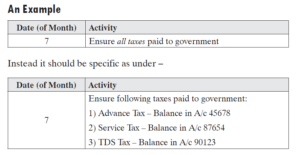
We know Checklist is a good thing but somehow it does not seem fast or flexible enough to what we face at work.
Over a decade of faith and practice, I have come to 9 benchmarks on Office Checklist :
1. The reason we don’t take our Checklists seriously is – because it isn’t up-to date. And the reason we don’t update our checklists is – because we don’t know where the soft copy of the checklist is !
So have a sub-directory where all checklists are maintained. Once you have the same, all it will take to cement a learning is to just go and update the specific checklist (Excel) file.
2. In the rush of work, it is easy to send an email to a team leader / team member – “Going forward, please ensure this.”
Don’t. Evaluate, and if required, send a specific message to your 1-downs, “I think you should incorporate this in your checklist.” This prod will be enough for them to diligently evaluate and update their checklist.
Your 2-minute email will help save hours and days down the line, in preventing an error or a lapse.
3. Regulatory items should be there in two checklists – the person who is responsible for the job, and one level above.
4. Avoid generics in your checklist.

5. In case you have numerous audits in the department, you can collate all the observations in a separate worksheet, linked to the main checklist as under –

Once you update as above, you can forget the 10-pager audit reports. Your checklist is complete; a standalone document in itself. Additionally, the checking can now be delegated down the line.
6. At the start of each month, take a printout of your checklist and stick it to your dashboard.
Then go tick, tick, tick. Make this a habit; don’t rely on your mind to remember.
7. Apart from manager, team leader, and team member, the need arises for one more type of checklist: Activity Checklists.
Some activities – say Account Opening, Income Computation, etc. – a) are critical in nature, b) have frequent updates, c) attract exceptions – and so should have detailed checklists of their own.
8. Learning is everywhere.
Learning is across all departments – be it Operations, IT, HR, Customer Service, Accounts –and at all levels – vice president, manager, team leader, and team member. In that sense, the obligation to (continue to) codify their learning in a checklist – for continued due diligence – is on all.
Further, a Manager (HDFC Bank, Chandni Chowk Branch, New Delhi) will have a different learning than a Manager (HDFC Bank, Karol Bagh Branch, New Delhi). I mention this because at times what you get is a central-office advised checklist (an Excel spreadsheet or a software-administered checklist which you have to sign-off at end of day). While that is a good start, it can never keep up with what you experience on the ground. So you will have to keep adding to that central-office advised checklist.
9. Lastly, and this comparison will amuse you, I always look upon checklists as a Police Nakabandi.
The first thing the police do when a crime occurs is to cordon off the area (nakabandi).
Likewise, when I see some change – an error, an audit observation, a process note, etc. – the first thing I do is reach for my checklist, How am I locking it in for long-term adherence?
—
This article is part of the bigger article – How to reduce errors at Work?